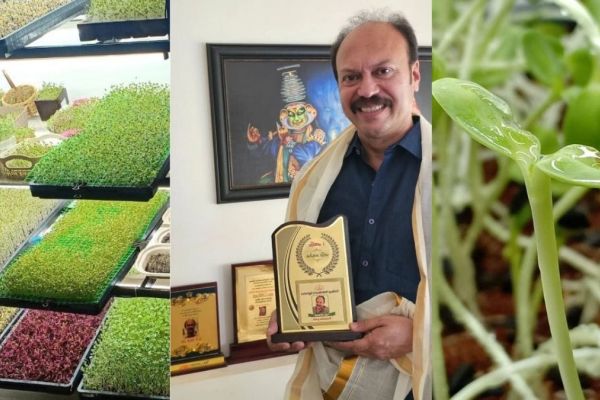Selfless Souls
Fifty-plus Ajay Gopinath saw microgreens for the first time. Two leaves and a stem, thrown in as seasoning on his food at a restaurant in Bangalore caught his attention instantly. Soon, he started researching them, only to find that the three-inch sized herbs or vegetable confetti not only adds flavour and colour to your plate but is also rich in nutrients. He now farms only microgreens after quitting his mundane bank job…
Q: How did you develop an interest in microgreens?
Two leaves and a stem, thrown in as seasoning on my food at a restaurant in Bangalore caught my attention. Soon, I started researching them, only to find that the three-inch sized herbs or vegetable confetti not only adds flavour and colour to our plate but is also rich in nutrients In fact, they are 40 times more nutrient-rich than the matured vegetables we eat every day. After quitting my bank job, I now farm microgreens full-time and for the past 1.5 years, I have been selling around 15 varieties of microgreens cultivated in two rooms of my 80sqft house. This small space yields almost 10kg of microgreens. Green mustard, yellow American mustard, bok choi, and sunflower grow seamlessly under my roof, alongside radish varieties like sango purple, China rose, red, and white.
Q: How did you start?
Watching YouTube tutorials, I began my experiments with beans. Placing the seeds on wet tissue paper and newspapers, I managed to grow some, but I wasn’t content with the result. Later, I found authentic methods to farm them. I realised not all seeds are microgreens after attending a short-term class held by a UK-based grower. Microgreen seeds are non-genetically modified organisms (GMO), non-hybrid, non-treated and open-pollinated. I source the seeds from Pune, Bangalore, and Chattisgarh.
Q: Do microgreens also need specific growing conditions?
Since the miniatures carry more health benefits than a mature plant, to retain them, they have to be grown in a place with ample moisture, humidity, and particular temperature. Placing an air conditioner and dehumidifier, I maintain the room temperature below 27 degrees, and humidity at 40 to 60 per cent. Seeds will sprout on newspaper, tissue paper or even plastic but a more hygienic, efficient medium is Low EC cocopeats. After distributing the seeds onto the cocopeat placed in food-grade trays with holes. they are then taken to a dim lit room with good air circulations. In two days, the seeds will germinate, and they will be taken to the grow room. After the sprouting stage, the first pair of leaves or cotyledon leaves will form in seven days. Then they can be called microgreens, and they should be cut and distributed immediately.
Q: Who do you supply your microgreens to?
I supply microgreens only to those in a two-kilometre radius around my house. If it is kept in the refrigerator, it can stay fresh for up to 8 days, otherwise, it will decay.
Q: Can everyone eat microgreens?
If doctors have asked you to watch protein consumption, you must avoid microgreens. Since they have Vitamin K, those who consume medicines for blood thinning should avoid them completely. Overeating microgreens is also bad. An adult only needs around 25gm. If you eat too much of them, you may feel constipated.
Q: What are the benefits of eating microgreens?
Microgreens are rich in nutrients and contain higher amounts of vitamins, minerals, and antioxidants. Vitamin B12 and Omega 3 fatty acids, distributed in non-vegetarian food are available in microgreens as well making these little herbs an important part of vegan and vegetarian diets. Polyphenols prevent ovarian, breast, and prostate cancers to an extent. The presence of Vitamin E is beneficial for preventing diabetes and Alzheimer’s in pregnant women, and sunflower microgreens help in breast milk production,” says Ajay.
Q: Should microgreens be cooked or must one eat them raw?
As per my knowledge, around 150 varieties of microgreens are available in the world, and India has 25 to 30 varieties. All of them are to be consumed raw. Stems and leaves are the only parts that should be consumed. The microgreens have a high water content, so when cooked they are likely to lose the protein and mineral content. If you can’t eat it raw, you can sprinkle them on already-cooked salads, rolls, and soups.

















Leave a comment